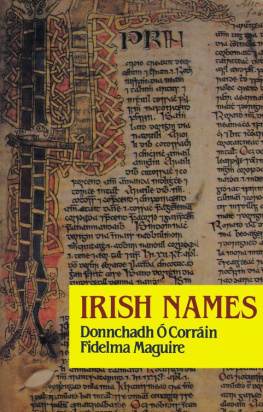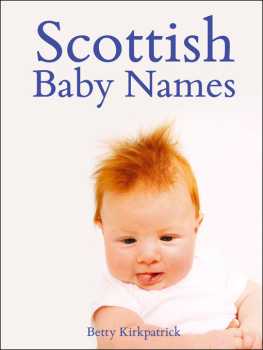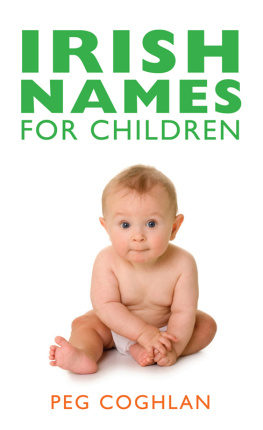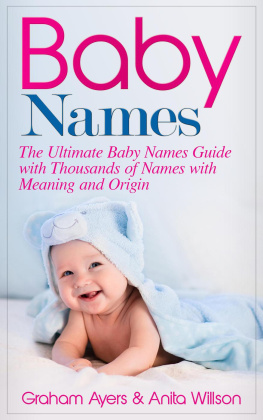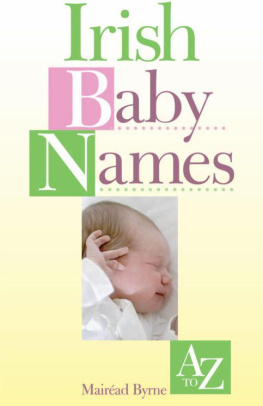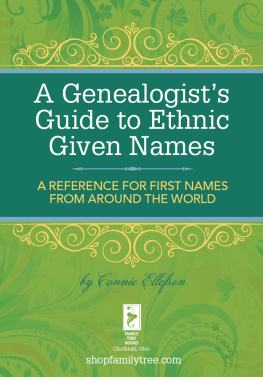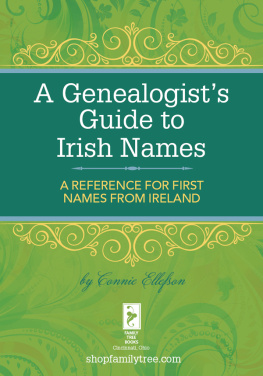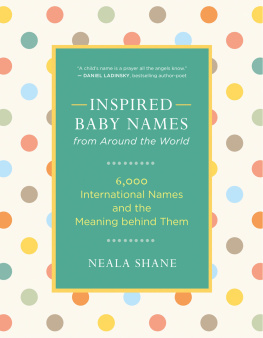for
Tiarnn&Saorla,
Gormlaith&Aengus
This book is intended as a selection of Irish names for children. In the ten years since it was written there have been noticeable changes in naming patterns. There are two trends, and both lead to a greater diversity of names.
Firstly, names have become more international. There has been a tendency to use continental or at least exotic forms of names already well established here in more familiar forms, e.g. Karen, Annemarie, Karl, Marc, Ivan. This is middle-class and reflects the outward-looking European-minded attitudes now fashionable for some time. And films, soap-operas and TV series play their part.
Secondly, Irish names in the original forms or with minimal anglicization have made great progress. We hope we have helped. Class lists show that among boys now in school in urban Cork Irish names, as first or second names, make up about half of all given names, but the number will vary greatly from class to class and from group to group and there are regional and minority patterns. The range is narrow: Brian, Finnbar (Barry), Kieran, Kevin, Niall, Conor, Brendan, Colm, Diarmaid, Dnal, Aidan and Rory are by far the most popular. However, boys names tend to be strongly conservative, though Patrick (and with it Pdraig) is in sharp decline.
Not so girls names. These are highly innovative and the variety, from sources of all kinds, is much greater. Irish names make up 30 to 35 per cent of our samples. Far the most popular Irish name is Aoife almost twice as common as its nearest competitor, Emer. Other very popular names: Deirdre, Fiona, rla(ith), Sinad, Niamh, Ciara, Clona, Dearbhail. In a sample of 416 primary-school children there are only 14 Marys (including all forms of the name) our statement that it is borne by one in four of the women of Ireland is quickly going out of date but there are 20 Aoifes, 12 Emers, 10 Deirdres and 11 Fionas. In this sample there is not a single example of Bridget (Brd) in any of its many forms (it is in rapid decline everywhere) and there is only one Nirn, as against 7 Julies, 7 Nicolas, 6 Michelles and 3 Lorraines. Novelty on all sides!
It would not be right to draw too many firm conclusions from these figures, but it seems that names are changing rapidly. The history of Irish names is complex and often bewildering, and there is a lot of research to be done. We would be glad of information on rare or obscure Irish names and unique translations. Recently, for example, our good friend Foxy John OMoriarty of Dingle was able to tell us that Seanchn was a hereditary name amongst the OMoriartys. They later translated it as Jonathan.
Belatedly, we should like to thank K.W. Nicholls who drew generously on his unique knowledge of the records to help us with names in the late medieval and early modern periods.
CarraiganDin,
Spring1990
D. C.
F.M.
The early Irish had an extraordinary variety of personal names. Indeed, some twelve thousand names are recorded in the early sources. Yet only a handful of names drawn from a rich heritage are in current use in Ireland. Thousands of them fell out of fashion at a very early period. In the later middle ages the range of names in general use was greatly narrowed and when English became the dominant language of the country, common English, biblical and classical names frequently replaced native ones. This book contains just under a thousand Irish names selected from the annals, genealogies, mythology and historical literature of early medieval Ireland. We have also admitted a number of borrowed names which were once (or still are) well established here, some introduced by early Irish clerics, some by the Anglo-Normans. Any selection poses problems of choice and we have attempted to follow some principles. For instance, we have tried to include all the most popular native names in use in Gaelic Ireland down to the nineteenth century together with their variant forms and their sometimes odd translations into English. We have also included rarer and more obscure names for different reasons: because they were (or are) traditionally attached to particular families, because they are the names of once famous saints, kings or heroes, because many of them are euphonious and may appeal to people for their sound or sense.
Irish names are enjoying an increasing popularity and we have tried to encourage that fashion because we believe that names carry cultural values and have powerful historical associations. Above all we have tried to extend the range of Irish names currently available by drawing on the rich record of the past, much of which remains unpublished or hidden from the general public in scarce or expensive scholarly books. We have also tried to deepen appreciation of Irish names by giving their historical and family associations, the surnames which derive from them, the famous people in mythology and history who bore them and, where possible, their meaning . We have noted which names were borne by Irish saints and the associations and feast-days of these saints.
Because of the sheer abundance of Irish names, borrowed ones have only been sparingly admitted. Recent borrowings, exotic variants and fancy-names have been almost totally excluded in favour of those which have been established here for centuries. Even then, we have had to be highly selective. For example, the vast bulk of the new names brought into this country first by the Normans, and later by the English, belong to the common fund of western European names. Many of these have been omitted because they can be found in any good dictionary of names. However, a large number of those which took firm root here, developed Irish forms or have interesting associations are included.
In one language, with the passage of time, names develop many variant forms and spellings. In Ireland, with the widespread replacement of Irish by English in the nineteenth century and before, change was even more marked. People substituted English names for Irish or made unusual, not to say bizarre, translations which differ from time to time and from place to place. This poses the problem of finding a standard form, a problem which we cannot say we have solved satisfactorily. We have decided to use an alphabetical order and have given first and as head-word the older Irish form, second the modern Irish form or forms, and third the various anglicised forms and translations where they exist. In that way, all the various forms of each name are placed together under one head-word and the index is designed to refer the reader to the appropriate head-word in each case. Examples are given below in the section How to use this book.
Irish names are constructed in a number of different ways. Some contain a single element, others two or more elements linked closely to form a compound or just loosely joined together. Aed,Lug,Cian are examples of the first type; Murchad,Donnchad,CUlad,MelMuire examples of the second type. While the ultimate meaning of some names is self-evident, many others are extremely obscure. As Professor M.A. OBrien has said: unlike an ordinary word the meaning of which can be determined, a name has no meaning. We do not, for example, call a child John because it means in Hebrew Jehovah has favoured, nor do we associate this meaning with a person so called in everyday life. Likewise, a girl is not called Rose because of the meaning of the name it is derived from Old German hros a horse. A name rapidly becomes a label with many more powerful associations than its meaning, which generally fades into the background. The meanings suggested in this book are, in many cases, no more than educated guesses. Many names may have been borrowed from earlier languages completely unknown to us and may simply have been given a Celtic form. Had we no knowledge of Irish and the change from Irish to English in Ireland, who could guess that

